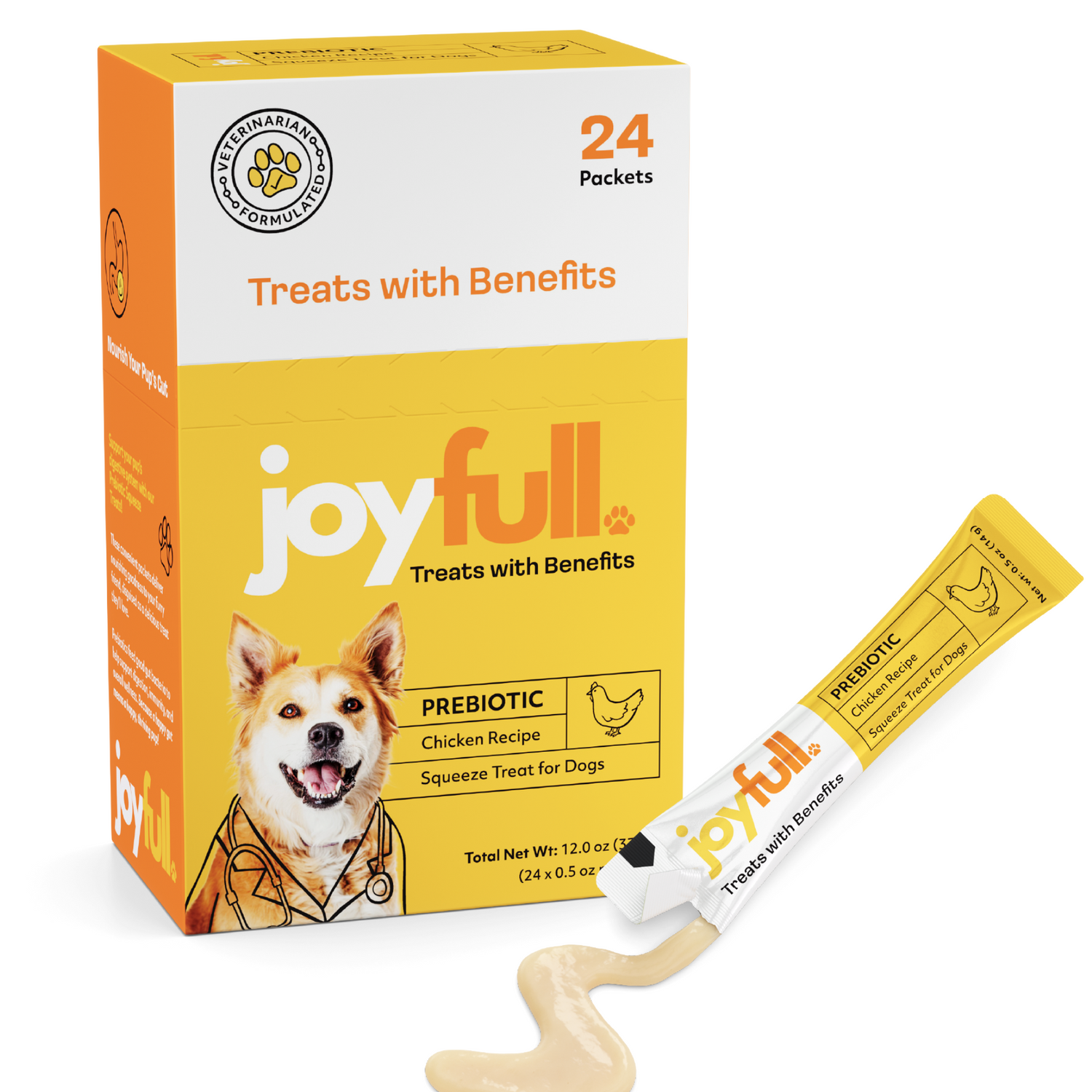
Discover Top High Protein Dog Treats for Your Dog’s Wellness
High-protein dog treats are so much more than a simple reward. Think of them as functional fuel, specifically designed to support your dog’s muscle development, keep their energy levels steady, and boost their overall vitality. These treats are a powerful supplement to a balanced diet, using high-quality protein to help your four-legged friend truly thrive.
Why Protein Is the Ultimate Reward for Your Dog
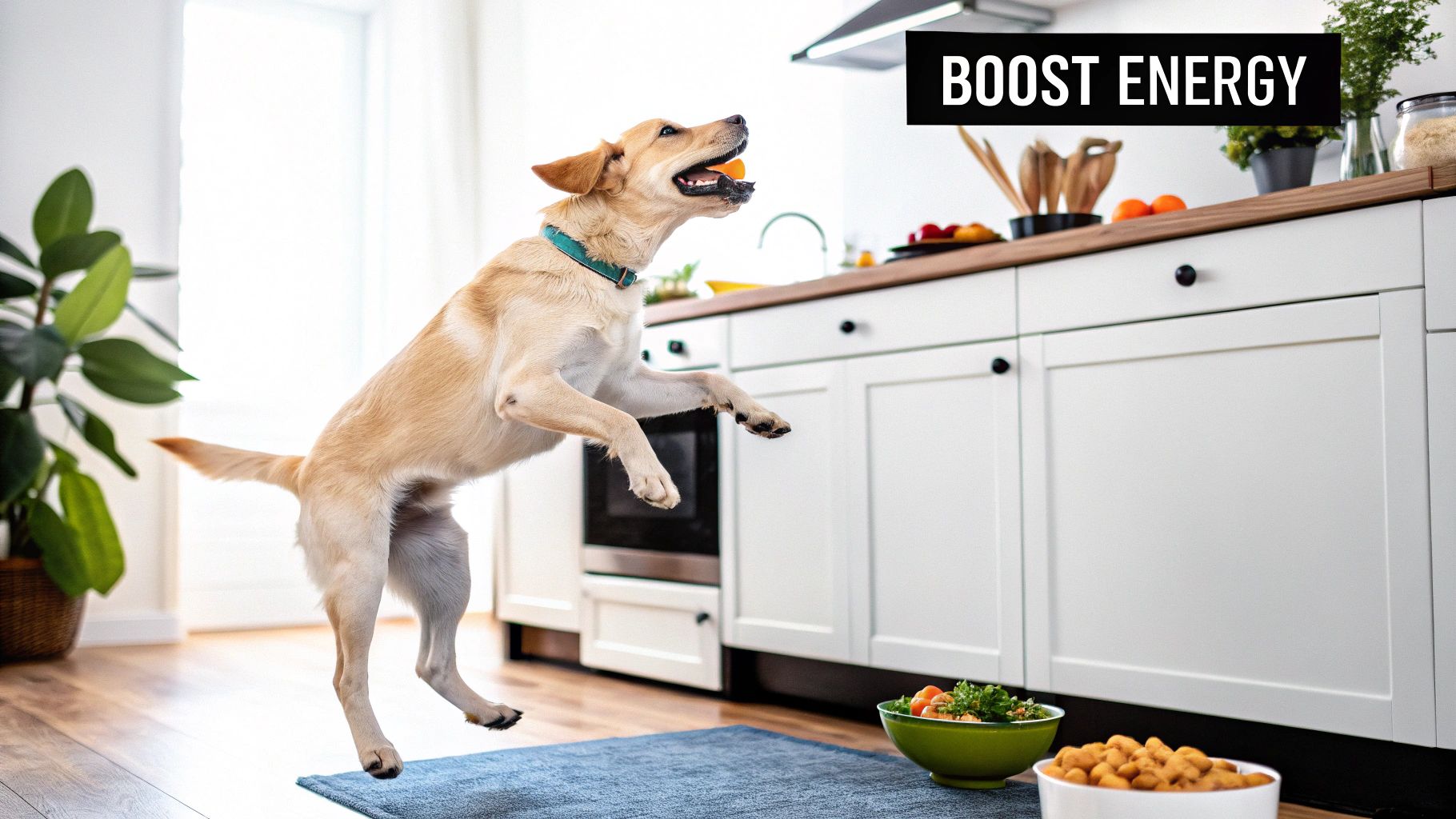
Imagine protein as the master "construction crew" for your dog's body. It’s not just another ingredient on the list; it's the essential building block for creating and maintaining just about everything—from their muscles and skin to their hair and nails.
When you reach for a treat, you're at a crossroads. You can either offer empty calories or provide functional fuel that genuinely contributes to their well-being.
High-protein dog treats fall squarely in that second camp. They aren't doggy junk food. Instead, they serve as a valuable supplement that reinforces a healthy, active lifestyle. The amino acids in protein are absolutely essential for everything, whether it's repairing tissue after a long hike or powering their immune system.
Fueling Every Stage of Life
A dog's protein needs aren't static; they shift and change as they grow. The right high-protein snack can deliver targeted support right when they need it most.
- Energetic Puppies: In that whirlwind growth phase, puppies need a ton of protein to build strong muscles, bones, and developing organs.
- Active Adults: For dogs in their prime, protein is all about maintaining lean muscle mass, fueling endless games of fetch, and repairing the tiny muscle tears that happen during normal play.
- Graceful Seniors: Older dogs often start to lose muscle mass. A protein-rich diet helps them hold onto their strength and mobility, supporting a much better quality of life in their golden years.
Choosing a treat packed with protein means you’re actively contributing to your dog's structural health with every single reward. It’s a simple switch that turns a moment of joy into a powerful opportunity for nourishment.
Getting a handle on protein’s role is the first step to making smarter choices for your pet. When you prioritize clean, high-quality protein, you're making a direct investment in their long-term health and happiness.
If you're ready to go a bit deeper, you can learn more about the benefits of high-quality protein for dogs and see how it impacts everything from their coat to their energy. This kind of foundational knowledge gives you the power to pick out treats that actually make a difference.
How to Read Labels and Identify True Quality
Walking down the dog treat aisle can be a dizzying experience, with every brand shouting about its benefits. But the real secret to finding a genuinely high-quality, high-protein treat isn't on the front of the bag—it's in the fine print on the back. The ingredient label tells the true story.
Think of the ingredient list like a recipe, with everything listed in order of weight. Whatever there's most of comes first. For a top-tier protein treat, you want to see a specific, named whole meat right at the top of that list.
The Power of Named Proteins
High-quality labels don't hide behind vague language. You'll see clear, identifiable sources like "deboned chicken," "beef," "lamb," or "salmon." These are the gold standard because they're highly digestible and packed with the complete amino acid profiles your dog needs to build and maintain healthy muscle.
On the flip side, vague terms are a major red flag. Phrases like “meat by-products” or “animal meal” are deliberately ambiguous and often signal lower-quality, less digestible protein sources. While they aren't necessarily harmful, they just don't deliver the same nutritional power as whole meats.
This quick infographic gives you a good baseline for how much protein you'll find in common whole-food ingredients.
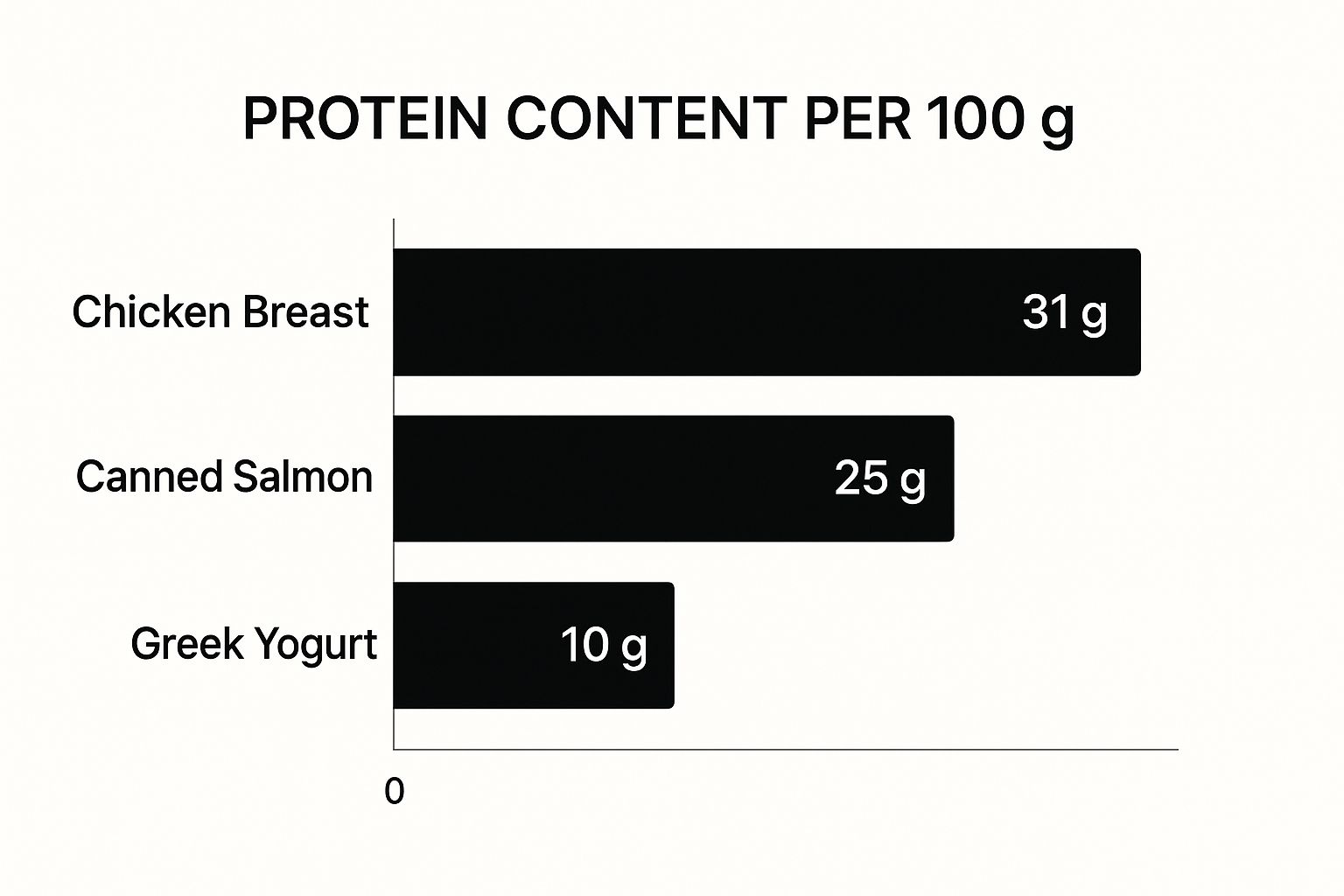
As you can see, whole animal proteins like chicken and fish deliver a serious protein punch in every bite.
To help you spot the good from the not-so-good, here’s a quick comparison of common protein sources you'll find on treat labels.
Comparing Common Protein Sources in Dog Treats
| Protein Source Type | Examples | Digestibility & Quality |
|---|---|---|
| High-Quality Animal Proteins | Deboned Chicken, Beef, Lamb, Salmon, Turkey, Duck | Excellent. These are whole, identifiable meats that are easily digestible and provide a complete amino acid profile for muscle development and repair. |
| Good-Quality Meat Meals | Chicken Meal, Lamb Meal, Salmon Meal | Good. A concentrated protein source made by rendering (cooking down) animal tissues. The quality depends on the source, but named meals are far better than generic ones. |
| Vague/Lower-Quality Sources | Meat By-Products, Animal Meal, Poultry Meal | Variable to Poor. These are ambiguous terms for a mix of leftover parts. They lack transparency and often have lower nutritional value and digestibility. |
Choosing treats with high-quality, named protein sources ensures your dog is getting the best fuel possible.
What Makes a Treat "High Protein"
So, what does "high protein" even mean? Generally, it applies to treats with a protein content of over 30%. This isn't just a marketing buzzword; it's a response to what educated pet parents are demanding. The market for high-protein dog food and treats is expected to jump from USD 8.28 billion in 2025 to a massive USD 12.67 billion by 2035.
This shift shows that owners are more aware than ever of protein's vital role in their dog's health, with 44% of U.S. dog owners now actively looking for high-protein options.
By prioritizing treats with identifiable, whole-meat proteins at the top of the list, you ensure every reward is packed with purpose. It’s the difference between a sugary snack and a functional, muscle-building supplement.
Becoming a savvy label-reader is one of the best skills you can develop as a dog owner. It empowers you to see past flashy marketing and make choices based on real nutritional science. For a deeper dive, check out our complete guide on how to read dog food labels.
The Real-World Benefits for Your Dog's Health
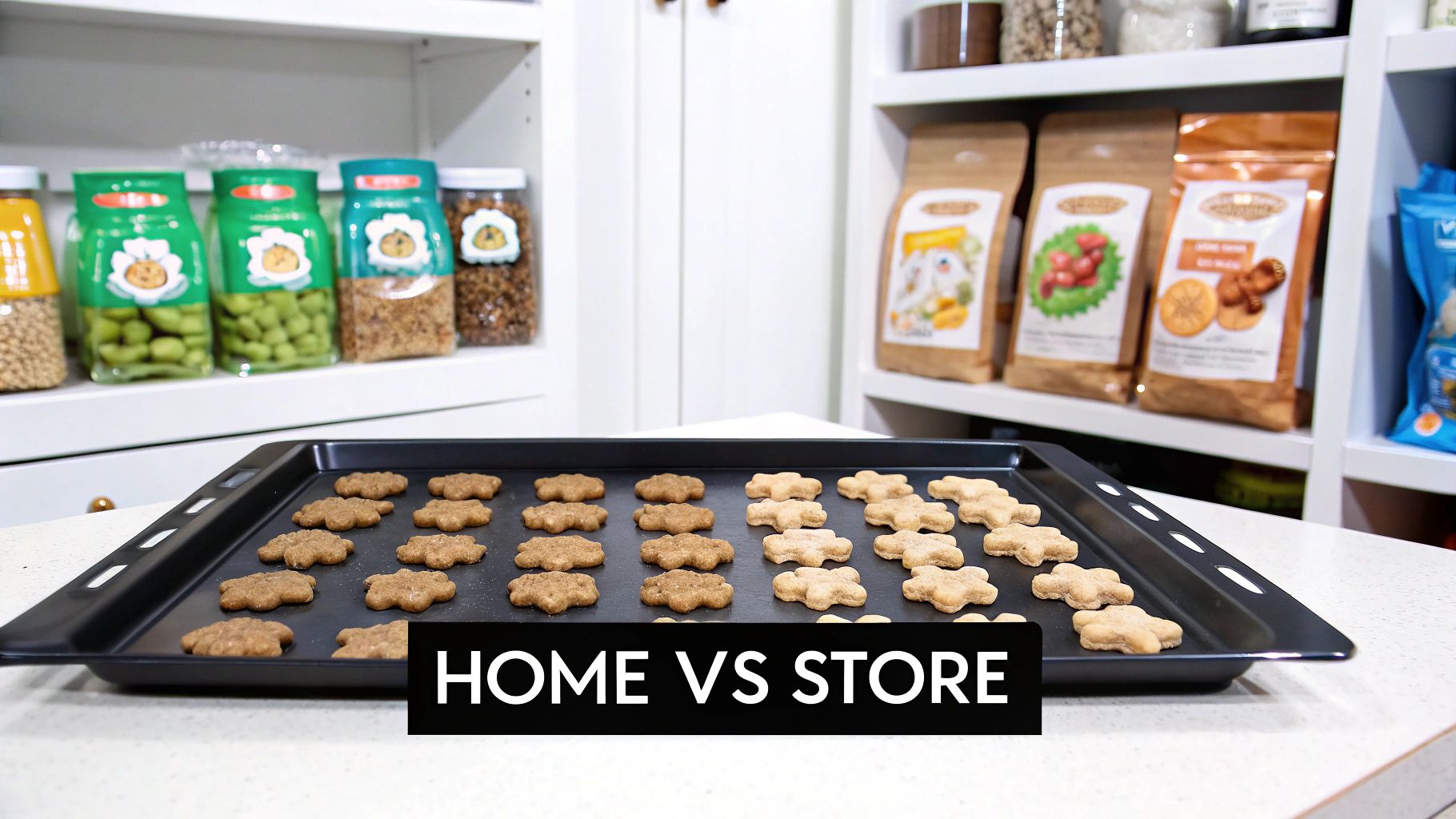
When you choose high-protein treats, you’re doing more than just giving your dog a reward for good behavior. You're making a direct investment in their health, and you'll see the payoff every single day. Think of these treats less like snacks and more like tiny, powerful building blocks for a healthier, more vibrant life.
One of the biggest wins is for their muscle health. Protein is the essential fuel for building and maintaining strong, lean muscle. This isn't just for canine athletes; it powers everything from those joyful sprints at the dog park to simply helping your senior dog get up comfortably from a nap.
Then there's the energy factor. So many dog treats are loaded with simple carbs and sugars, creating a classic energy spike followed by a "sugar crash." High-protein treats do the opposite, providing a slow-burning, sustainable fuel source that keeps your dog's energy levels steady and consistent throughout the day.
Supporting a Healthy Body and Shiny Coat
Protein is also a game-changer for weight management. It’s more satisfying than fats or carbs, which helps your dog feel full and content for longer. This natural appetite control can make all the difference in keeping them at a healthy weight.
Finally, the most visible proof is often right on the surface. A dog’s skin and coat are made almost entirely of protein. When you supply them with high-quality protein, you're giving their body the exact materials it needs for a strong, shiny coat and resilient, healthy skin.
You’re not just giving a treat; you're providing the specific nutrients needed for a shinier coat, stronger muscles, and more consistent energy. It’s a small change that yields visible, positive results in your dog's daily life.
These four benefits—muscle support, stable energy, weight management, and a healthy coat—all work together. It's a simple formula, really. A dog with strong muscles, consistent energy, and a gleaming coat is the very picture of health. To dig deeper into this, you can learn more about a high-protein diet for dogs in our detailed guide.
While high-protein treats are a fantastic start, the world of general nutrition supplements for dogs offers even more ways to boost their vitality. By focusing on quality ingredients, every treat becomes a moment that actively contributes to your dog's long-term health, ensuring they feel as good on the inside as they look on the outside.
Exploring Novel and Alternative Protein Sources
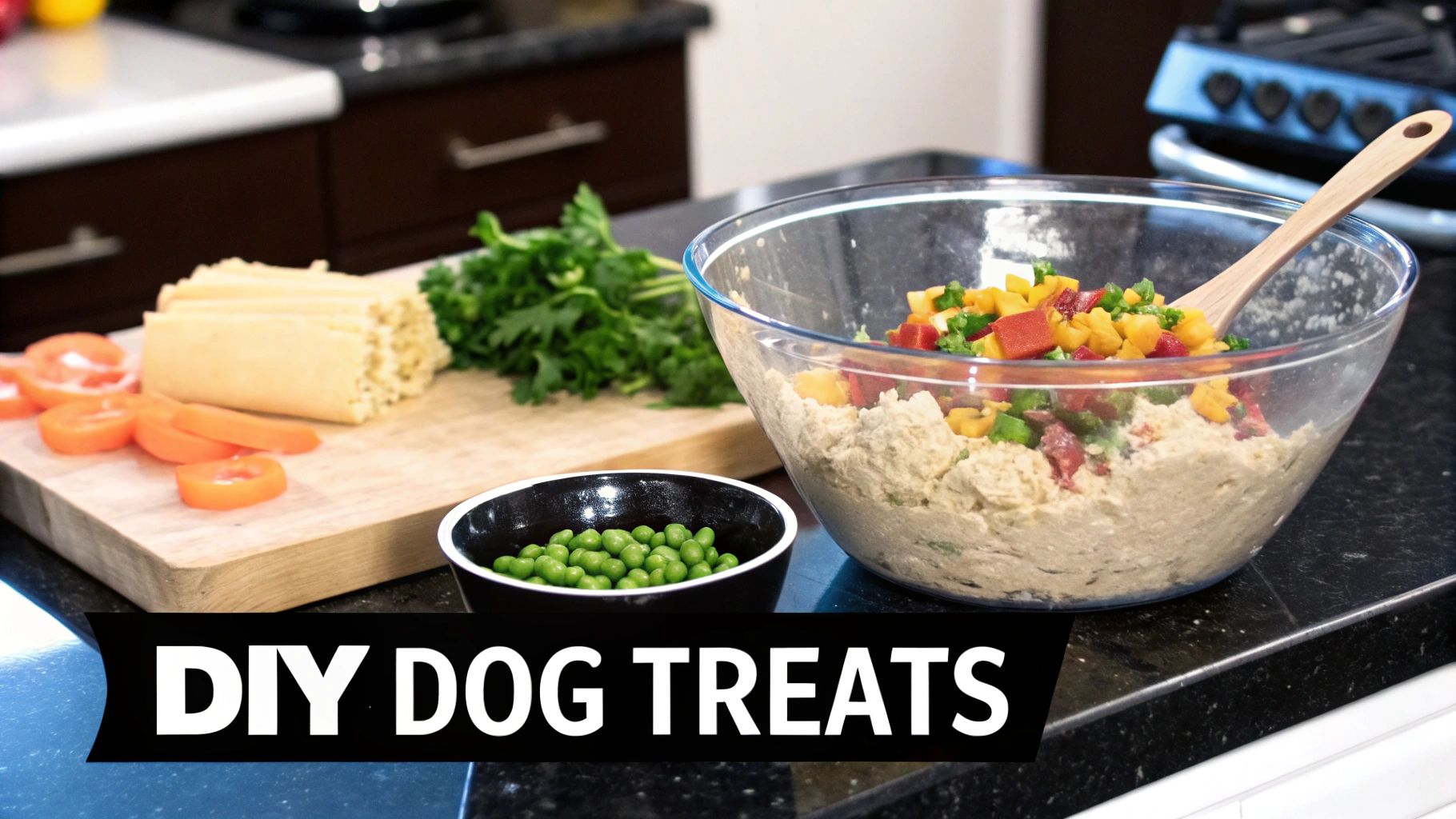
When we think of protein for our dogs, chicken and beef usually come to mind first. They’re the classics for a reason! But just like in our own diets, variety can be a game-changer, which is why a lot of savvy pet parents are now looking at novel and alternative proteins.
So, what exactly is a novel protein? It’s simply a protein source your dog hasn’t eaten before. If your dog has spent its life eating chicken-based food, then something like duck or venison is "novel" to its system.
This is especially important for dogs with food sensitivities. Think of their immune system as a bouncer at a club. If it sees chicken and beef all the time, it can sometimes get overzealous and start flagging them as troublemakers, leading to itchiness or tummy troubles. But when a new protein like rabbit shows up, the immune system doesn't have a record of it and is far less likely to overreact.
More Than Just a Hypoallergenic Fix
The benefits of switching things up go way beyond just managing allergies. Many of these alternative proteins bring their own unique nutritional superpowers to the table and often come with a smaller environmental pawprint.
- Duck: This isn't just a tasty option; it's loaded with iron and essential amino acids that are fantastic for building and maintaining strong muscles.
- Venison: As a naturally lean red meat, venison is lower in fat and cholesterol. It’s also packed with B vitamins, zinc, and iron—all critical for keeping your dog's energy levels up and organs healthy.
- Rabbit: A highly digestible white meat, rabbit is incredibly gentle on the digestive system. This makes it a perfect pick for dogs who need something easy on their stomach.
Novel proteins offer a powerful solution for managing food sensitivities by introducing ingredients the immune system hasn't been conditioned to react against. This simple swap can bring significant relief to dogs suffering from chronic itching or digestive upset.
The Next Wave: Sustainable Proteins
Looking ahead, you'll start seeing even more unique ingredients like insect protein. Before you turn up your nose, things like black soldier fly larvae are nutritional powerhouses, and they’re incredibly sustainable—requiring far less land, water, and resources than traditional livestock.
This shift toward unique, functional ingredients is a huge driver in the pet treat industry. What was a USD 44.2 billion market in 2025 is expected to explode to USD 336.3 billion by 2035. Producers are leaning into this by offering treats with exotic proteins, which can fetch margins 40-60% higher than standard ones. It’s a clear sign that pet owners are prioritizing specialized, health-forward nutrition. You can dive deeper into these popular pet treat trends to see where the market is headed.
Ultimately, choosing a treat with a novel protein isn't just a trend. It’s about being at the forefront of modern pet wellness, providing targeted nutrition that can be both gentle and good for the planet.
Smart Treating: How Much Protein Is Just Right?
Giving your dog a high-protein treat should be all about joy, not worry. But it's easy to wonder, "Am I overdoing it?" The secret to getting it right is a simple guideline that veterinarians have trusted for years: the 10% rule.
Basically, treats shouldn't make up more than 10% of your dog's daily calorie intake. Think of it this way: their regular kibble or wet food is the main course, packed with all the balanced nutrition they need to thrive. Treats are the delicious, fun extras that enhance their day without throwing that core diet out of whack.
No Two Dogs Are the Same
Of course, the 10% rule is a fantastic starting point, but every dog is a unique individual. You'll want to dial things in based on what makes your dog, well, your dog.
Here’s what to keep in mind when figuring out their personal treat allowance:
- Activity Level: A tireless Border Collie who spends the day herding sheep (or just chasing squirrels with unmatched intensity) will burn far more calories than a Basset Hound who has perfected the art of the nap. More active dogs can handle a few more treat calories.
- Age and Life Stage: A growing puppy has different energy needs than a senior dog who might be slowing down and more prone to packing on a few extra pounds.
- Overall Health: Protein is amazing for building and maintaining muscle, but you have to be mindful. For dogs with certain kidney issues, for example, too much protein can be hard on their system.
Remember, a treat is a special reward, not a second dinner. Sticking to the 10% rule ensures these high-protein snacks are a healthy bonus, not something that disrupts the carefully balanced nutrition they get from their main meals.
When you use this simple framework, you can feel great about rewarding your pup. It's the best way to give them the muscle-supporting goodness of high-protein treats while keeping them at a healthy weight for the long haul. And as always, if you have any specific concerns, your vet is the best person to ask.
The Big Shift in How We Feed Our Dogs
When you reach for a high-protein, high-quality treat for your dog, you're not just giving them a snack—you're part of a massive, positive shift in how we think about pet care. The old days of viewing dogs simply as pets are long gone.
What we're seeing now is a trend called “pet humanization.” It’s a simple idea with a huge impact: we see our dogs as true members of the family. And just like any other family member, they deserve the best, especially when it comes to what they eat.
This change in mindset is shaking up the entire pet food industry. It's the reason we're all looking for cleaner, more transparent ingredients in everything we buy for our dogs, from their kibble to their training rewards. We're reading labels, asking questions, and holding brands to a higher standard—just like we do for our own groceries.
The Rise of the Savvy Pet Parent
This isn't just a fleeting trend; it's a powerful force changing the market. Today's dog owners are more informed than ever. We're actively looking for treats that do more than just taste good—we want them to offer real, functional benefits.
We're turning our backs on empty fillers, mysterious by-products, and artificial junk. Instead, we're drawn to foods and treats made with the same kind of healthy, whole-food ingredients we'd choose for ourselves.
The humanization of our pets means we’re searching for top-tier, nutritionally packed options that look a lot like our own healthy diets. It completely validates the choice to invest in high-quality ingredients for them.
The numbers back this up loud and clear. The global market for high-protein dry dog food, a category that includes high protein dog treats, is already massive. Valued at around $5 billion in 2025, it’s expected to grow by 7% every year through 2033.
Why the boom? It’s a direct result of owners like you demanding better options and the rise of online brands that make it easier to find them. You can dive deeper into the data by exploring the growth of the high-protein pet food market.
At the end of the day, making your dog's nutrition a top priority is simply part of being a modern, responsible owner. It’s about recognizing that every choice—even something as small as a single treat—is a chance to support their health and happiness for years to come.
Got Questions About High-Protein Treats? We've Got Answers.
When you're trying to do the best for your dog, it's natural to have questions. Picking the right high-protein treat can feel like a big decision, but getting straight answers makes it easy.
We hear a lot of the same questions from loving pet parents just like you. Let's clear up some of the most common ones so you can treat your dog with total confidence.
Are High-Protein Dog Treats a Good Idea for Puppies?
Yes, absolutely! Puppies are little building sites, and high-quality protein is the premium material they need to construct strong muscles, healthy organs, and a sturdy skeleton.
Just remember the golden rule of treats: the 10% rule. No more than 10% of your pup's daily calories should come from treats. Their main nutrition needs to come from a complete and balanced puppy food that's formulated for this critical stage of growth. Always look for treats made specifically for puppies to ensure they're the right size and texture for their little mouths.
Is It Possible for a Dog to Get Too Much Protein?
For a healthy, active dog, a protein-rich diet is not only safe but incredibly beneficial. Their bodies are literally built to use it for energy, muscle repair, and overall health. If they take in more than they need, their system simply flushes out the excess. No harm done.
The only time to be cautious is if your dog has a known kidney issue. In that very specific case, a high-protein diet can put extra stress on their kidneys. If you have an older dog or one with any diagnosed health problems, it's always smart to have a quick chat with your vet before changing their diet.
The real conversation isn't about "too much" protein—it's about the quality of that protein. A digestible, whole-meat source is always better than a treat packed with low-grade fillers, no matter what the protein percentage on the bag says.
What’s the Best Treat for a Dog with a Sensitive Stomach?
When you're dealing with a sensitive tummy, think simple. The shorter the ingredient list, the better. Look for treats with limited ingredients, which dramatically cuts down the chances of including something that will cause an upset.
Another great strategy is to try a novel protein. That's just a fancy way of saying a protein source your dog has never eaten before—think duck, rabbit, or venison. Since their body hasn't been exposed to it, there's a much lower risk of a bad reaction. For most sensitive dogs, a novel protein in a simple, clean recipe is the perfect combination.
Ready to give your dog a treat that’s as healthy as it is irresistible? Check out the full line of clean, high-protein snacks from JoyFull. We’re firm believers that a healthy life isn't just for people—our pets deserve it, too. Shop our collection today!
